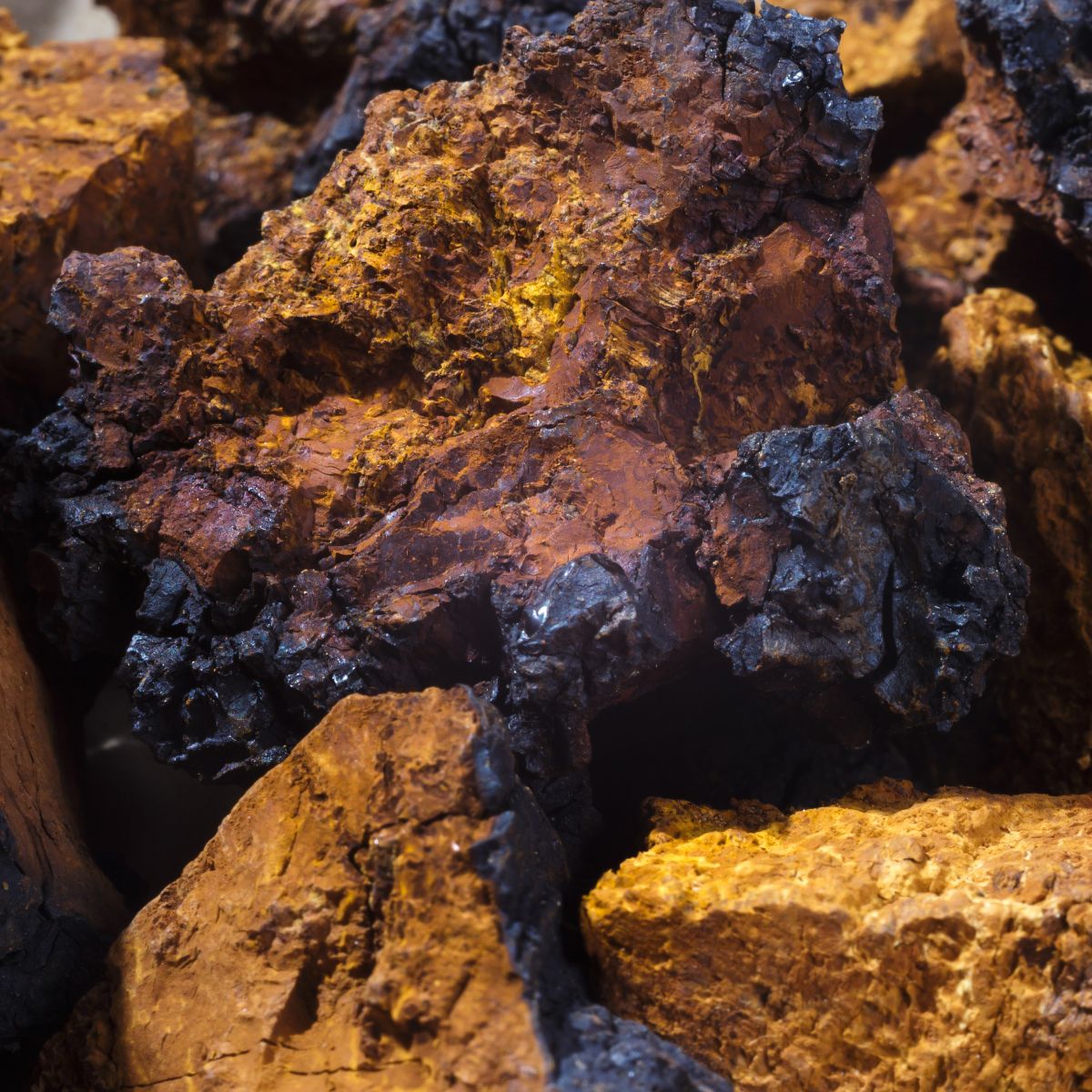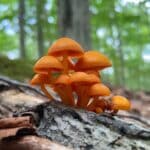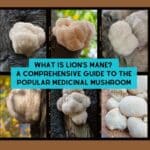This species, Inonotus obliquus, is a parasitic fungus that grows on birch trees. It has a long history as a medicinal mushroom in Russian and Polish folk medicine.
You may have seen one before and not even known it. It appears as a large, black, burnt-looking mass sticking out of the side of a tree. Perhaps you’ve even marveled at one, feeling sorry for the tree, as it appears to have some sort of extra-terrestrial, creepy growth bursting out of it.

Yet this growth is not technically even a mushroom! Rather than a fruiting body, it’s just a big, hard ball of mycelium. Mycelium is the actual organism behind a mushroom. If you think of a mushroom as an apple, mycelium is the tree that causes the apple to fruit with the intention of reproduction.
This article will explore this fascinating fungus and try to answer some questions. What health conditions will it help? How do you get it and how much should you take? And just what the heck does “chaga” mean anyway!?!

Jump to:
Chaga as a Medicinal Mushroom
You might not think that a gnarly black mass would be all that healthy, but the use of chaga as a medicinal mushroom dates back to the 16th century (possibly earlier).

Inonotus obliquus appears in Russian folklore as a treatment for a variety of ailments and as a general tonic. It is also popular in Poland, Finland, and other regions of Eastern and Northern Europe. You may have heard of “Siberian Chaga”, as birch forests in Siberia are said to produce the world’s most powerful strain.
What are the health benefits of chaga? As with so many medicinal mushrooms, there’s a lot of hype and confusion. Yet more research is now beginning to confirm what folk medicine has claimed for years:
- Strengthens the immune system – One of the biggest claims to fame is that it is a very effective adaptogen. This means it strengthens the immune system to deal with outside stressors, everything from daily pollution to mental stress.
- Powerful anti-oxidant properties – The removal of damaging free radicals results in organs that work more efficiently and better looking skin. This is why this fungus is sometimes referred to as an anti-aging herb. (I personally hate the term ‘anti-aging’ but there you go).
- Gastro-intestinal support – It has a reputation for helping those with inflammatory bowel disease and Crohn’s. By bolstering the immune system, it can provide relief from ulcers and other gastric problems.
- Support for cancer patients -The reputation as a cancer treatment goes back hundreds of years, with lots of new research in the last 10 years. It helps prevent metastasis, eases the side effects of chemotherapy/radiation, and has even shown anti-tumor activity by killing cancerous cells themselves.
- Strong anti-bacterial and anti-viral properties
It’s worth noting one famous study reported that the anti-tumor activity was only active after a lengthy heating process, not just from steeping a simple tea from the raw material (Lucas, 1959 from Hobbs’ “Medicinal Mushrooms”).

What are the side effects of chaga? Not many. The only warning I was able to find in my research was that, due to its immune stimulating activity, those on immune suppressing drugs for organ transplants probably shouldn’t take it.

The medicinal actions of this “mushroom” are due to its high levels of Beta-D-glucans, a type of polysaccharide (long-chained carbohydrate molecule). It also contains other chemicals that stimulate the immune system such as triterpenoids, phenols, sterols, and enzymes.
Why is chaga so powerful and why does it make these chemicals in such abundance? The theory is that is needs them to survive in its natural habitat: cold birch forests.
By strengthening itself and the tree, it can keep them both alive in harsh winters so that it can continue to feed. And when you’re trying to thrive in the Siberian forests, you want as powerful an immune system as you can get!
Chaga Controversy

Yet for all these wonderful molecules and immune boosting power, it isn’t without controversy. I believe in chaga as a medicinal mushroom, but I think we should be wary of any product advertised as a cure-all.
The disagreements over Inonotus obliquus don’t end with advertising:
- Some claim that only Siberian chaga is worth taking, and that the mushroom from other parts of the world doesn’t contain nearly as many health benefits.
- Some say that it can be overharvested, and that removing too many growths can damage the local ecosystem.
- Many teas and other simply prepared products claim to be cancer fighting, yet research indicates that a simple brew may not be enough to activate these properties.
This can be very overwhelming! What’s an environmentally responsible person who wants to be healthy but can’t get the time off from work to fly to Siberia to do!?!?
My advice? Do your research but don’t get overly analytical unless you have a serious health condition such as cancer (then you may want to seek out wild-harvested chaga that’s been prepared for such conditions).
I do think there are good products on the market. Just experiment and see how you feel! The hype around this mushroom is immense, so do your research with a specific health benefit in mind (I’ve done some of this for you below).
For more information on the history, research, and science of Inonotus obliquus I’d highly recommend checking out this page.

Where to Find Chaga and How to Dose
There are a number of different ways to start supplementing with chaga, most involving preparations made by different companies.
It’s generally accepted that the tea is used as more of a daily tonic, but if you have a health condition something stronger is recommended. Try making a tincture, extract, or pills instead.

Although easy to find in many parts of the world, it’s not always so easy to harvest. If you find it growing on a tree and if you’re sure it’s chaga and if it’s within reach, you’ll probably want to give up after a few minutes of hacking at it with a knife. This is not a soft little mushroom but a hard mass that’s difficult to remove.
Thus for some it’s easier to just buy a prepared product. Yet be careful! As we know, not all herbal products are created equal.
Below explores some of the main ways to take your fungus and how to do it. Evaluate with respect to what you think is best for your health, wallet, and level of patience!

Choosing The Type of Chaga
Many places will sell you chaga in small pieces or in a pre-ground powder. This route is often my favorite way to take medicinal mushrooms, as you can usually get way more of the actual product for the same price as purchasing a bottle of pills.
Make sure your powder comes from a reputable company that uses ethical harvesting practices.
I find the Sayan brand powder to the the best. It’s wild harvested, and gives you a noticeable energy boost. The product on the right is about a month worth of powder for about $23.
Once you have your powder you can:
- Make your own capsules using a pill machine. Most “00” capsules hold between 250 to 750 mg (.25 to .75 gram) depending on the powder. Encapsulate your powder, determine roughly the amount per pill (total grams of powder divided by number of pills you made), and dose accordingly. (Start with 1-2 grams/day and work your way up to 3-5 for serious health conditions).
- Make your own chaga tea. I’ve read conflicting information as to whether or not you should boil finely ground chaga. What’s recommended instead is a delicate simmer. Let 3-4 teaspoons simmer gently for an hour. You can strain and use again. The tea is more of a daily tonic rather than a treatment for serious conditions.
- Make your own chaga tincture. Put the powder or pieces in a clean glass jar and cover it with strong vodka (at least 50 proof). Place the jar in a dark place for 4 to 6 weeks, shaking occasionally. Take 1/2-1 teaspoon twice a day. This preparation will last for years!
- Make your own powerful chaga extract. Simmer your pieces gently for an hour. Save the water, strain, and then simmer again. Then take both decoctions, put them together, and simmer them down until it’s just a gooey paste, which will take a few hours. Be gentle! Don’t boil it just to get it down quicker. This results in a strong, paste-like extract that can be put into capsules. Start with 2 per day (1 morning/1 night), moving up to 4 per day for serious health conditions.

Purchasing Chaga Preparations
Would you rather spend a few extra bucks to save time preparing your medicinals? I can respect that. I love making my own concoctions, but I know some people just aren’t interested or don’t have the time.
Fortunately there are many mushroom products out there, but unfortunately that means you have to wade through a lot of junk to find the good ones.
Look for a product that:
- Is ideally organic or ethically harvested
- Is from a reputable company
- Has a website that is informative about the product they sell
- Actually tells you where the mycelium came from
Some of the preparations you can purchase are:
- Tincture/Extract – These come in small bottles that only require a few drops a day. For cost versus efficiency versus effect, a tincture or extract is often the best deal.
- Capsules – Some companies will sell you the prepared capsules, saving you the time of having to make them yourself. This can be a more expensive option, so make sure you buy from a reputable brand. For prepared mushroom pills, you usually can’t go wrong with the ones from Fungi Perfecti (now called Host Defense).
- Tea – Yes, you can buy mushroom teabags. This is often the most expensive option, but some people love the simple act of brewing the tea for an afternoon treat. I often stay away from the prepared teas as they cost more and sometimes contain stevia, which I hate! So I don’t have any recommendations for prepared tea, although you can buy it on Amazon (research the companies first).

How To Harvest Your Own Chaga
Sometimes when you want something done right, you have to do it yourself. Or in this case, when you want something done cheaper!
Harvesting your own chaga is free if you have the time, tools, and knowledge. You will need some sort of axe, as removing them can be difficult. You may also need a ladder to reach them, something I don’t do. (I hate those unstable death traps known as ladders.)
Look for the fungus from spring to fall in birch forests. You may also find it growing on other trees such as elm or beech.
I wish I had some great pictures to show you of how to harvest but sadly I don’t. However, you can find such pictures, along with great information, at the Mushroom Collecting chaga page. While you’re there check out the rest of the site, run by the Mushroom Maineiac and all around cool guy David Spahr.

Some Fun Facts About Inonotus obliquus
- The word chaga is an anglicization of the Russian name for the fungus, spelled чага.
- It goes by many other names, some of the more famous are clinker polypore, cinder conk, birch mushroom, and birch canker. It has awesome names in other languages too, such as Schiefer Schillerporling (German).
- The fungus is a parasite that preys on living or dead trees. They’re most commonly found on birch, but also on elm, beech, and ash.
- For all its medicinal uses, the clinker polypore has an unappetizing appearance. A hard, black mass of irregular shape growing on the sides of trees, it has no stalk, many cracks, and looks as if it has been burnt.
- The black mass you see on trees is a big scrunchy ball of mycelium, not an actual mushroom fruiting body. Apparently the fungus does produce a mushroom fruiting body, which is rare and not often seen. (I’ve never seen one or even a picture of one!)
- It may appear as a smaller ball but can grow relatively large. Up to a few feet across.
- You’ll find the fungus in forests (mainly birch) in many different parts of the world, particularly Russia, Poland, Northern Europe, Canada, and the Northern United States.
- This is one of the species of fungi referred to as a “tinder fungus”, for it’s ability to be used as fire starting material. (Although the mushroom known as the true tinder fungus is Fomes fomentarius).
- The season in which chaga appears is long, from anywhere in the spring to late fall.
I hope you’ve enjoyed learning about this weird yet powerful fungal growth! Now that you know where to find chaga and what it is, perhaps you want to start experimenting with it yourself.










Nathan
Is there any beach or elm trees in Northern Minnesota
Jenny
Yes, and birch, but not sure how common they are there. You might want to contact your local forests department, or local mycology clubs to see if they find Chaga where you are.